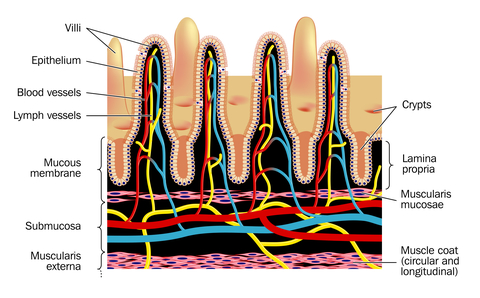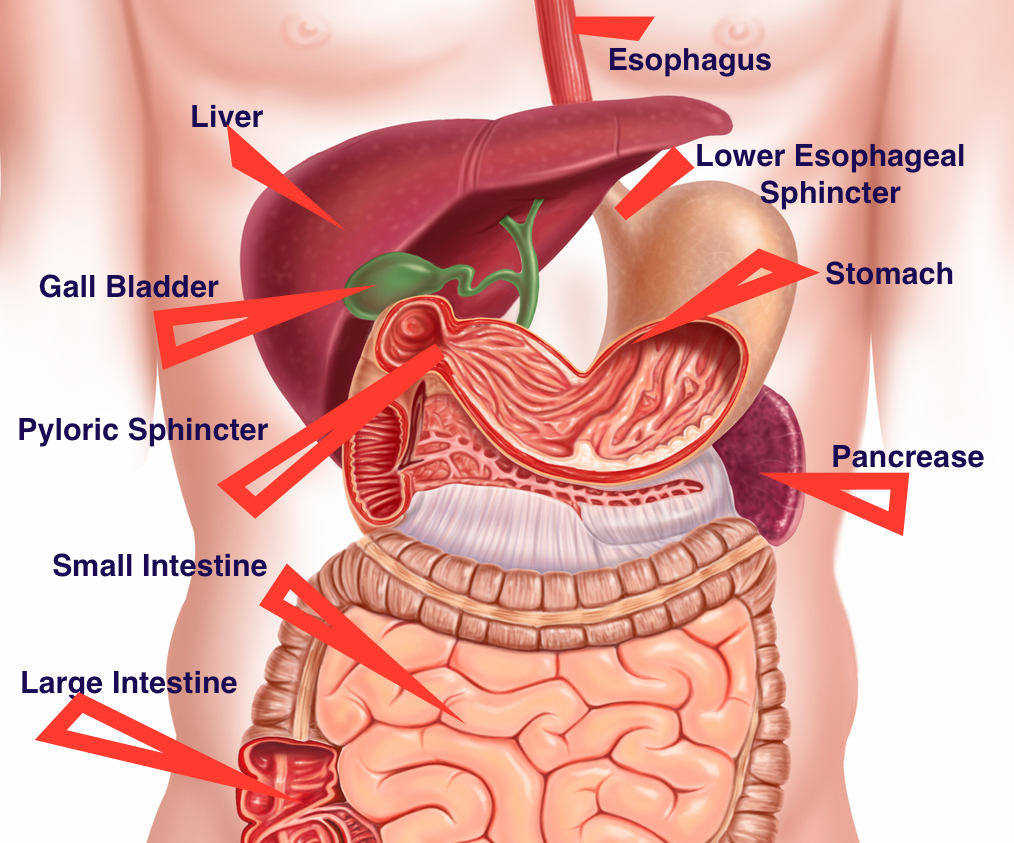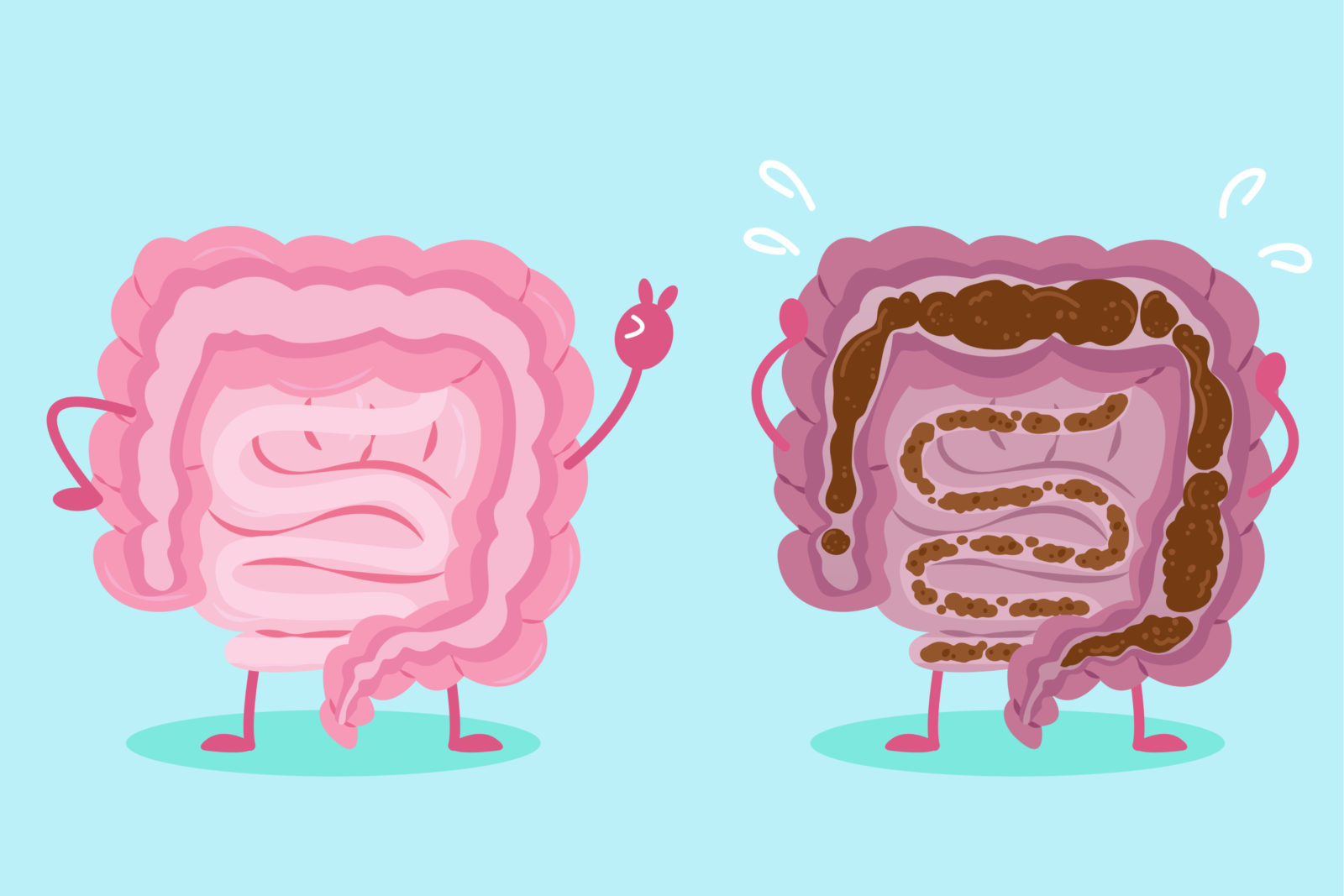Bloating and gas are two very common symptoms of small intestinal issues. Your small intestine begins with the pyloric sphincter (the doorway between the stomach and the small intestine) and ends with the ileocecal valve (the doorway to the large intestine) and in-between is 15-20 meters of tubing lined with tiny fingerlike projections called villi. These villi are epithelial tissue, covered completely by thousands of microvilli. They are accountable to the body to manufacture digestive enzymes, absorb nutrients and prevent the uptake of unwanted substances that will have no use in the body – they are efficient that way.

Loss of Migratory Motor Complex
Migratory motor complex (MMC) is the control mechanism of the small intestine. After you have eaten and all your food has left the small intestine by the ileocecal valve and entered the large intestine, the small intestine the migratory motor complex comes into action and pushes all the leftovers derby and bacteria out of the small intestine and into the large intestine. MMC happens about every 90 minutes during fasting. If you happen to eat every two hours this process is either cut short or does not take place.
How do we end up losing our Migratory Motor Complex?
You go on a trip to some exotic place, to the United States or a restaurant down the street. You can get pathogenic bacteria (E.coli, Salmonella, Campylobacter jejuni, Shigella, etc.) anywhere. Your stomach acid is responsible for breaking down food. It is also there to vanquish any bad bacteria that we may ingest along with what we eat.
If stomach acid is low or the food eaten contains a lot of pathogenic bacteria, it can lead to digestive upset. The pathogenic bacteria arrive first in the stomach and shortly will make its way into your gut. It releases a cytolethal distending toxin (CDT), which puts the immune system on high alert to eliminate the unwanted intruder.
As the pathogenic bacteria move into the small intestine the immune system begins to attack it. There is a cell that makes up the lining of the gut called the interstitial cell of Cajal (ICC), whose job is migratory motor complex. It is this cell’s misfortune to look ever so similar to pathogenic bacteria.
As the immune system is defending the body it can accidentally bring damage to the ICC of the small intestine. By damaging them, MMC is also damaged and it is no longer able to effectively eliminate waste and bacteria that remain in the small intestine. Peristalsis may get rid of the rest later on, but not everything. This leads to a buildup of undigested food that ferments and releases gas in the small intestine. This results in bloating and the eventual overgrowth of small intestinal bacteria.
Small Intestinal Bacterial Overgrowth (SIBO)
The small intestine will naturally have some bacteria in it. Approximately < 100 thousand good and bad bacteria reside in the last portion of the small intestine called the ileum. If the cyclical motility of the migratory motor complex has stopped the bacteria will build-up. This is primarily the build-up of normal commensal bacteria or indigenous bacteria.
Another way we can get a build-up of this indigenous bacteria is if the ileocecal valve is not closing properly. The small intestine will always (unless we vomit) move chyme forward. The large intestine will go to and through, up and down, for as long as it sees fit. This isn’t so much a problem if the ileocecal valve is closed, but if it has trouble staying closed bacteria has the potential to move on up into the small intestine.
If bacteria gets into the small intestine from the large intestine and the MMC is working, most commonly the bacteria will be pushed out. If it is not it has the potential to multiply and wreak havoc. This occurs when the small and large intestine can get bowel pockets. These small crevasses will collect decomposing food and bacteria. They are unaffected by the motion and commotion that occur in the gut and here they will multiply. This results in the development of SIBO or small intestinal bacterial overgrowth.

Other reasons SIBO can develop
SIBO often develops as a result of a prior or present health condition or physical complication within the small intestine. By getting to the underlining cause of SIBO the risks associated with it and its persistence in the body can be eliminated.
- Gastrointestinal (GI) infection – Crohn’s disease, ulcerative colitis
- GI Surgery – gastric bypass, blind loops, removal of Ileocecal valve
- Chronic stress – digestion shuts off as we are often in a constant state of fight or flight.
- Age – with age the acidity of the stomach decreases = food not being properly digested thus leading to a possibility of bacterial overgrowth either through fermentation in the gut (food not being able to be absorbed by the body is left to feed them especially carbohydrates) or through the loss of MMC.
- Antibiotics – potential to change the microbial landscape in the gut.
Symptoms of SIBO
- abdominal bloating or distension
- constipation or diarrhea or a mixture of both
- abdominal pain
- acid reflux/heartburn
- an exorbitant amount of farting and burping
- nausea
- brain fog – trouble concentrating or remembering things
- tired or weak
- underweight or struggling to gain weight
- nutrient deficiencies
Why is SIBO an issue?
The small intestine normally has very few bacteria present. It becomes an issue when the indigenous bacteria grow out of control and lead to the development of SIBO. SIBO wreak havoc on the small intestine and subsequently the body as a whole. The damage it brings includes the following.
Mucosal Damage
Mucosal damage brings about inflammation to the epithelial lining of the small intestine. It weakens the villi making them less efficient at the work they need to conduct.
Increased Permeability
Increased permeability of the digestive tract which can lead to the development of IBS (irritable bowel syndrome) along with other digestive issues.
Deconjugation of Bile
When bile is released from the gallbladder it is conjugated (meaning there is a double bond), it needs to be in this form to break down fats in the small intestine. Bacteria will attempt to break these bonds apart – deconjugating the bile – if there is too much bacteria present this becomes a serious issue. The body cannot absorb an excessive amount of fat, resulting in fat globules coming out in the stool. Deconjugated bile harms the cells of the small intestinal lining – primarily brush border enzymes. Transporters on the small intestinal lining that bring nutrients into the body get damaged.
Bacterial Consumption of Nutrients
Bad bacteria and other opportunistic organisms in the gut will begin to compete and consume nutrients. In turn, this leads to the production of hydrogen, hydrogen sulfide and methane – hydrogen is linked to diarrhea and methane is linked to constipation (methane released by bacteria slows down transit time by 70% ). Both will irritate the gut and bring about bloating.
Bacteria Secrete Their own Enzymes
Enzymes secreted by bacteria aid in breaking down and digesting the food that the bacteria found in the small intestine. The enzymes are potent that they begin to eat away at the lining of the small intestine and our carbohydrate and sugar-digesting enzymes (saccharide- digesting enzymes) making it difficult to absorb carbohydrates.
What nutrients does SIBO fight over?
Vitamin B12
The body can absorb dietary B12 only if it is attached to intrinsic factor (which is produced by the stomach lining -along with HCL and pepsin). The pair makes their way to the small intestine where they have hopes of being taken up and used by the body. Unfortunately, with SIBO this becomes an issue, as the bacteria love to gobble up B12. They strip it away from intrinsic factors and without that B12 cannot be absorbed. Over time this can lead to B12-deficiency anemia.
Fat-soluble vitamins
Vitamin A, vitamin D, vitamin E, vitamin F, and vitamin K are essential fat-soluble vitamins. As bad bacteria deconjugate bile, they make it incredibly hard for us to digest fat and absorb these nutrients. Over time malabsorption of nutrients leads to malnutrition.
Best way to test for SIBO
A methane and hydrogen breath test is the best way to test for SIBO. A stool sample test will not work as it will only be a reflection of the environment in the large intestine. The hydrogen breath test for assessing SIBO can be done at home, with a medical practitioner or at a hospital. Two sugar solutions are used, both cannot be digested by the human body, however, they are consumed by bacteria. After consuming the sugar solution and the bacteria eat it, they will release gas. The gas crosses the intestinal lining, moves to the lungs and we breathe it out (the gases that we breathe out are measured).
The test takes approximately 2-3 hours. The breath is tested every 20 minutes during this duration. The test is rated as such;
Hydrogen – 20 parts per million = positive
Methane – 3 parts per million = positive
A combined score of 15 = positive
Please NOTE
- One of the two sugar solutions, ‘lactulose’ needs to be prescribed by a doctor.
- The test may make symptoms worse.
What can one do?
If you are feeling overwhelmed it is good to seek some advice and guidance, it’s hard to figure out where to start when you can’t see your insides or pinpoint where the problem exactly resides.
However, here are a few little changes that you can make.
- Positive vibes – love yourself. This really can’t be stressed enough. It may not happen overnight, but making sure you put out a positive outlook on all aspects of your life will make a difference in how you feel and how your body reacts to you.
- Carbohydrates – Consumption of carbohydrates needs to be limited, as they are the main food source for bacteria. Fruits, vegetables, and honey have simple sugars in them that don’t require a great deal of breaking down – making them quite easy to absorb. Grains and processed sugars and dairy need more work and therefore should be limited in the diet.
If you are interested in learning more about SIBO here is a great website to check out!
References
Cutler, E. W., & Kaslow, J. E. (2005). Micromiracles: Discover the healing power of enzymes. United States: St. Martin’s Press.
DiBaise, J. K. (2008). Nutritional Consequences of small intestinal bacterial overgrowth.PRACTICAL GASTROENTEROLOGY, 69, 15–28.
Enders, G. (2015). Gut: The inside story of our body’s most under-rated organ. Australia: Scribe Publications.
Erdogan, A., Lee, Y. Y., Badger, C., Hall, P., O’Banion, M. E., & Rao, S. S. (2014). What is the optimal threshold for an increase in hydrogen and methane levels with glucose breath test (GBT) for the detection of small intestinal bacterial overgrowth (SIBO)? Gastroenterology, 146(5), S–532. doi:10.1016/s0016-5085(14)61927-2
Ghoshal, U., Shukla, R., Agarwal, V., & Dhole, T. N. (2014). Fecal Microbiota in patients with irritable bowel syndrome compared to healthy controls by real-time PCR: An evidence of Dysbiosis. Gastroenterology, 146(5), S–532. doi:10.1016/s0016-5085(14)61926-0. Online Available at PubMed.
Gottfried, S., & Northrup, C. (2013). The hormone cure: Reclaim balance, sleep, sex drive, and vitality naturally with the Gottfried protocol. Philadelphia, PA, United States: Scribner.
Gottschall, E. G. (1994). Breaking the vicious cycle: Intestinal health through diet. Baltimore, Ontario: The Kirkton Press.
Hod, K., Ringel-Kulka, T., Van Tilburg, M. A., & Ringel, Y. (2014). Abdominal bloating in patients with irritable bowel syndrome: Characterization of clinical symptoms, psychological factors, and Associated Comorbidities. Gastroenterology, 146(5), S–532. doi:10.1016/s0016-5085(14)61925-9
Lipski, E. (2011). Digestive wellness: Strengthen the immune system and prevent disease through healthy digestion, fourth edition (4th ed.). New York, NY: McGraw-Hill Professional Publishing.
Siebecker, D. A., & Croxton, S. (2015). How to Beat the Bloat: Small Intestine Bacterial Overgrowth Retrieved from SeanCroxton.com
Siebecker, D. A., & Sandberg-Lewis, D. S. (2013, January 9). Small intestine bacterial Overgrowth: Common but overlooked cause of IBS. Retrieved August 19, 2016, from Naturopathic Doctor News and Reviews, http://ndnr.com/gastrointestinal/small-intestine-bacterial-overgrowth-2/
Siebecker, D. A., & Sandberg-Lewis, D. S. (2011, March 1). Small intestine bacterial Overgrowth: The case of the perpetual patient. Retrieved August 24, 2016, from Naturopathic Doctor News and Review, http://ndnr.com/pain-medicine/small-intestine-bacterial-overgrowth/
Amanda Filipowicz is a certified nutritional practitioner (CNP) with a bachelor in environmental studies (BES) from York University. She also has certification in clinical detoxification, prenatal and postnatal care as well as nutrition for mental health. She has been working as a nutritionist since 2013 and is a lifelong proponent of eating healthy.

